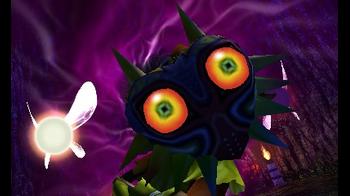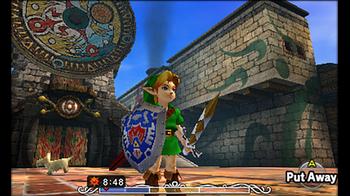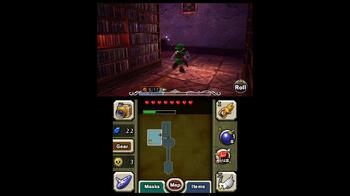
The Legend of Zelda: Majora's Mask 3D Review
The Legend of Zelda: Majora’s Mask is without a doubt the strangest entry in the franchise. Within the opening minutes you encounter a creepy looking mask, eerie music, a frightening transformation sequence, and you soon learn that the world is coming to the end in 3 short days. Nothing else in the series comes close to the unusual tone and tense nature that Majora nails right from the onset.
But it’s not just in the musical choice, visual aesthetics, and character design that make Majora's Mask a strange game. You are greeted with a countdown clock staring at you from the bottom of the screen at all times. Wait too long and a Game Over is sure to follow. This ‘time limit’ might alarm people initially, but once you realize how much control you have over time, it’s clear to see that it becomes the fundamental element that allows the game to work in the first place.
But it’s not just that either. Majora’s Mask takes a bit of focus away from completing dungeons and puzzle solving - elements that are a staple for the series. While those pieces are still present, of course, players will actually find themselves spending a lot of time – if not the majority of it – interacting with NPCs and learning their schedule in order to solve their problems. This is all tracked in a Bomber’s Notebook, and completing these subquests can lead to heart pieces or masks, often used for additional quests.
With the repeating three day cycle, Majora welcomes exploration of a different kind. Most games have some sort of extra sidequest, or hidden objectives that usually come about by wandering the nooks and crannies of the map. This time a temporal element adds a new dimension to exploring the world of the game.
The game is very open ended from the beginning. While direction is given in order to progress through the primary tasks, most of the rest has to be figured out from the player. Certain events happen at specific times and some only if other events at other times have been completed. Learning how the schedules of NPCs, actions made by Link, and how it affects Termina ends up as an addicting undertaking in addition to more typical Zelda gameplay. This is done by exploring, talking to NPCs, and manipulating time to continually understand the world and characters.
Coming back to more traditional Zelda elements, the dungeons found in Majora’s Mask are also largely stellar. While few in number, each offers an interesting structure and behavior. Having various control types with Deku, Goron, and Zora Masks allow for a bit of ingenuity in puzzle design and layout outside of pushing blocks and small keys. The sense of progression from dungeon to dungeon is well paced too, culminating in the Stone Tower Temple, one of the best dungeons in the 3D series due to interesting mechanics and challenging but appropriate level of complexity.
The 3DS update provides numerous enhancements from the original game. All character models have been touched up, the framerate has been solidly improved, the dual screen interface allows for easier item and mask management, text boxes flow faster, and dungeon maps are easier to use.
In addition to usability improvements thanks to the 3DS system, a number of other changes have also been introduced to suit a handheld experience. Some are very sensible when considering the new platform, some are mostly negligible with no significant impact, and only a few add some new issues. Saving is now ‘detached’ from the time cycle and can be done at both Owl Statues and Feather Statues littered around the world, the latter of which being added in the 3DS version.
Other tweaks include an improved Bomber’s Notebook which keeps track of quests in addition to NPC schedules. While the quest tracker is a little bit intrusive in how it updates each time progress is made in any subquest, I found it very useful to stay on top of things considering the sheer number of them found throughout the game. Changes made to Zora swimming creates more problems than they solve, but it’s nothing that ruins an otherwise fantastic remake.
The most obvious changes to those familiar with the game are found in the boss encounters. Each baddie has a Majora-esque eyeball attached somewhere this time around, and the goal is to figure out how to expose it to damage. For some of the boss fights, the change is minimal. However, the later 2 dungeon bosses are quite varied from how they were in the original title. New swimming controls make the Great Bay Temple boss more arduous, but tweaks to the boss of Stone Tower Temple adds a bit of fun silly flavor.
The biggest missed opportunity for Majora’s Mask 3D is the lack of any sort of Hero Mode, Master Quest, or even Boss Rush type feature. Zelda games aren’t really known for their difficulty, but for players like myself re-experiencing the game, it would have been a great way in adding some challenge to make the game a little fresher for the replay. Especially coming off of Ocarina of Time 3D and A Link Between Worlds, which each had some sort of challenge mode, the fact that it is missing here is disappointing.
Delightfully bizarre, and with a structure not found often, Majora’s Mask easily stands the test of time. There’s simply nothing else quite like it. The improvements made to game performance and usability dramatically outweigh any new issues, and this version is the best way to experience this one-of-a-kind game.


